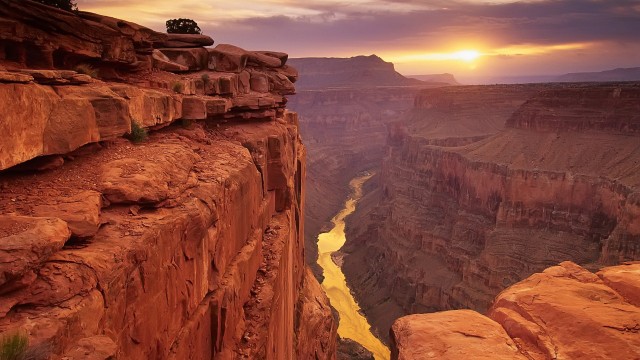Grand Canyon
WITH DIMENSIONS of 277 mi (446 km) long and 18 mi (29 km) wide, the Grand Canyon is one of the most spectacular natural wonders of the world. Crafted by the Colorado River, it is an enduring and unchallenged natural symbol of North America. At its present size of 1,904 square mi (4,911 square km), the Grand Canyon is the fourth-largest park in the lower 48 states of the UNITED STATES.
Formation of the canyon is a relatively recent event, in geologic time. The Grand Canyon is a vast landscape composed of layers upon layers of different kinds of rock that are distinct in color and texture. Basement rocks of black Vishnu schist, hard metamorphic rock, and granite form the inner gorge of the canyon. The Kaibab limestone found on the canyon crest is estimated to be 225 million years old.
River runoffs from the rims have cut hundreds of side canyons, which spread and gradually isolated the buttes and mesas that now tower thousands of feet above the canyon floor. Half of the Earth's history is represented in the rocks at the Grand Canyon. On its walls, four geologic eras are visible in the sedimentary rocks. The fossils in its layers illustrate the evolution of life: Nowhere else in the world has been found a clearer view of geologic processes.

Climate at the canyon varies with the season and altitude. The North Rim, which is 8,000 ft (2,438 m) above sea level, receives so much snow that access by road is cut off to tourists all winter (late October to early May). Between June and August, normal daytime temperatures at the rim rise above 70 degrees F (21 degrees C), while nights remain somewhat cool. The South Rim, at 7,000 ft (2,134 m) above sea level, is open year-round. At night, the temperature still drops well below freezing between late October and April. Upper portions of hiking trails get dangerously icy. Between May and September daytime temperatures will have highs above 70 degrees F (21 degrees C) at the rim; no matter what the season, it is always much warmer at the bottom of the canyon.
The temperatures in the Inner Canyon, at river level—almost 5,000 feet (1,524 m) below the South Rim—are often in excess of 100 degrees F (38 degrees C) on most days between late May and early September. The temperature at the river is unlikely to drop below 70 degrees F (21 degree C) even at night. Little direct sun reaches the bottom of the canyon, but the bottom of the canyon seldom freezes, and December highs remain well over 50 degrees F (10 degrees C).
Precipitation in the canyon is fairly rare, except for some snow in winter and rain in August, when afternoon thunderstorms sweep in and blow over quite rapidly. The canyon receives 15 in (38 cm) of rainfall in an average year, and at any time during the year the canyon can be invisible beneath a layer of cloud or fog. Despite the fact that Grand Canyon boasts some of the cleanest air in the United States, air pollution from faraway cities, smelters, and neighboring power plants continues to reduce visibility at the Grand Canyon by 30 percent below natural levels. In September 2001, the owners of the Navajo Generating Station made an agreement with the Grand Canyon Trust to reduce sulfur emissions by 90 percent.
The Grand Canyon receives nearly 5 million visitors annually. Thirty percent are foreign tourists. Most come to the South Rim, stay only for a few hours, and use the many observation points to look across and down into the canyon. But to truly experience the Grand Canyon, one must go down in it. To get inside the canyon, tourists can hike down preserved trails or take a mule ride to the bottom of the canyon. Rafting whitewater rapids through the Colorado River is another way to experience the massiveness of the Grand Canyon from within. There are also several campsites inside the canyon for adventurers seeking to enjoy more than a few hours of the experience.
Cascading waterfalls plunge into waiting pools of water on the Havasupai Indian reservation, near the lower end of the canyon. The canyon was home to at least seven Native American tribes, and the Hopi Indians still regard the canyon as their place of emergence onto the Earth and the place where their dead return. Their predecessors left behind more than 3,000 archaeological sites and artifacts as old as 10,000 years. Home to 88 species of mammals and 315 species of birds, the Grand Canyon was declared a national monument in 1908, when President Theodore Roosevelt decided to protect it in perpetuity; in 1919 the U.S. Congress authorized the expansion and upgrading of the monument to a national park.